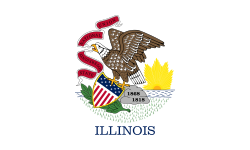Evanston, Illinois
- För andra betydelser, se Evanston.
| Evanston | |
| city | |
Charles G. Dawes hus i Evanston. | |
| Land | |
|---|---|
| Delstat | Illinois |
| County | Cook County |
| Koordinater | 42°2′47″N 87°41′39″V / 42.04639°N 87.69417°V |
| Yta | 20,2 km² (2010)[1] |
| - land | 20,1 km² |
| - vatten | 0,1 km² |
| Folkmängd | 74 486 (2010)[2] |
| Befolkningstäthet | 3 706 invånare/km² |
| Tidszon | CST (UTC-6) |
| - sommartid | CDT (UTC-5) |
| ZIP-kod | 60201, 60202[3] |
| FIPS | 1724582 |
| Geonames | 4891382 |
Ortens läge i Illinois | |
Illinois läge i USA | |
| Webbplats: http://www.cityofevanston.org/ | |
Evanston är en stad i Cook County i nordöstra Illinois i USA. Staden ligger vid Michigansjön och är en förort till Chicago. Den hade 74 239 invånare 2000. I staden finns Northwestern University.
Källor
- ^ ”2010 Census Gazetteer Files”. US Census Bureau. Arkiverad från originalet den 14 juli 2012. https://www.webcitation.org/699nOulzi?url=http://www.census.gov/geo/www/gazetteer/files/Gaz_places_national.txt. Läst 14 juli 2012.
- ^ ”Evanston (city), Illinois” (på engelska). State & County Quickfacts. U.S. Census Bureau,. Arkiverad från originalet den 29 juli 2012. https://www.webcitation.org/69WI2en0w?url=http://quickfacts.census.gov/qfd/states/17/1724582.html. Läst 29 juli 2012.
- ^ ”2010 ZIP Code Tabulation Area (ZCTA) Relationship Files”. U.S. Census Bureau. 31 juli 2010. Arkiverad från originalet den 25 augusti 2012. https://www.webcitation.org/6ABdwXxbq?url=http://www.census.gov/geo/www/2010census/zcta_rel/zcta_place_rel_10.txt. Läst 25 augusti 2012.
Externa länkar
 Wikimedia Commons har media som rör Evanston.
Wikimedia Commons har media som rör Evanston.
Media som används på denna webbplats
Shiny red button/marker widget. Used to mark the location of something such as a tourist attraction.
Författare/Upphovsman: Teemu008 from Palatine, Illinois, Licens: CC BY-SA 2.0
The Charles Gates Dawes House in Evanston, a national landmark (1909). Dawes lived at this residence from 1909 until his death in 1951. A descendent of William Dawes, Charles G. Dawes practiced law in Nebraska before moving to Chicago after losing most of his fortune in the Panic of 1893. He abandoned his business interests to pursue politics. He was instrumental in building support for William McKinley during the Republican primaries for the 1896 election. Dawes was appointed party treasurer. McKinley named Dawes the Comptroller of the Currency after his successful presidential bid. Dawes resigned in 1901 in a fruitless bid to win a senate seat back in Illinois. He established the Central Trust Company of Illinois in 1902, which became a leading bank. In 1907, he operated a bread wagon to distribute food to the poor of Chicago. Dawes was commissioned as a major in World War I and was one of the first troops to arrive in France. He rose to the rank of brigadier general, focusing on supply logistics. In 1921, President Warren G. Harding appointed Dawes the Director of the Budget.
In 1923, Dawes agrees to be the chairman of a committee that sought to address the German reparations following the war. Germany had defaulted on its obligations. The group worked for three months on the Dawes Plan to arrange a rational schedule of payments that were proportional to the success of the German economy. In 1925, Dawes was awarded the Nobel Peace Prize "for the Dawes Plan for German reparations which was seen as having provided the economic underpinning of the Locarno Pact of 1925." In 1930, the Dawes Plan was replaced by the Young Plan.
In 1924, incumbent Calvin Coolidge was quickly chosen as the Republic presidential candidate. Illinois governor Frank Lowden was nominated for the Vice Presidency, but he refused. Idaho Senator William Borah also turned down the opportunity, and Commerce Secretary Herbert Hoover was deemed too unpopular. The delegates at the convention eventually agreed on Dawes as the Vice Presidential Nominee. Dawes was elected Vice President on November 4, 1924. Dawes fought bitterly with Coolidge over many issues. After Dawes' term, President Herbert Hoover appointed him Ambassador to Great Britain. After two years, Hoover appointed Dawes as the head of the newly-founded Reconstruction Finance Corporation in the wake of the Great Depression. Dawes left after six months to tend to his failing bank. He died in 1951 and is interred in Rosehill Cemetery.
A curious music history footnote: Dawes was also a self-taught composer. His 1912 composition, "Melody in A Major", became a popular piano and violin song. Lyrics were added by Carl Sigman in the 1950s and the song became popularly known as "It's All in the Game". In 1958, Tommy Edwards recorded a version of the song in 1958 that hit #1 on the Billboard charts for 6 weeks. Dawes is the only Nobel Peace Prize winner or Vice President to be credited with a #1 hit.Författare/Upphovsman: Alexrk2, Licens: CC BY 3.0
Den här Det karta skapades med GeoTools.
Författare/Upphovsman: This version: uploader
Base versions this one is derived from: originally created by en:User:Wapcaplet, Licens: CC BY 2.0
Map of USA with Illinois highlighted








